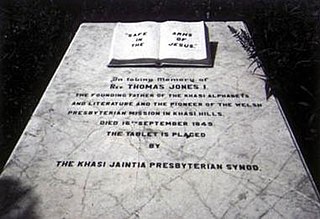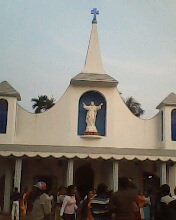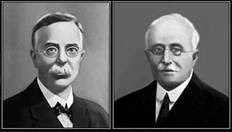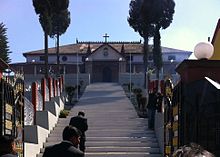The Presbyterian Church of Wales, also known as the Calvinistic Methodist Church, is a denomination of Protestant Christianity based in Wales.

Jowai is the headquarters of the West Jaintia Hills district of the state of Meghalaya, India, and is home to the Pnar, a sub-tribe of the Khasi people. It is located on a plateau surrounded on three sides by the Myntdu river bordering Bangladesh to the south. Due to its high altitude of 1365 m above sea level, Jowai experiences warm summers with cool to chilly winters.
John Hughes Morris (1870–1953) was a Welsh author and an administrator of Christian missions. He was born in Penrhosllugwy, Anglesey but moved to Liverpool as a young lad. He only received elementary education at Chatsworth School, Liverpool but he had considerable talent, and when he was 22 years of age he came to work at the office of the Foreign Mission in Falkner Street, near the Philharmonic Hall. This mission began in Liverpool in 1840 by the Presbyterian Church of Wales. Morris remained at this office till 1949, a period of 57 years.

Thomas Jones was a Welsh Christian missionary, who worked among the Khasi people of Meghalaya and Assam in India and of Bangladesh. He recorded the Khasi language in Roman script, and the inscription on his gravestone calls him "The founding father of the Khasi alphabet and literature".
Mizoram Presbyterian ChurchSynod is the largest Christian denomination in Mizoram, northeast India. It was a direct progeny of the Calvinistic Methodist Church in Wales. It was the first church in Mizoram and is now one of the constituent bodies of a larger denomination Presbyterian Church of India (PCI), which has its headquarters in Shillong, Meghalaya. The administrative body called the Mizoram Synod has its headquarters at Mission Veng, Aizawl. As the first church, it remains the largest denomination in Mizoram.

Christianity is one of the religions in Tripura, a state in North East India. According to the Indian Census 2011, the population of Christians in Tripura is 159,882 or 4.35% of the total population. Christians are mostly found among the indigenous communities of the state such as the Tripuri, Lushai, Kuki, Darlong, Halam etc. Among the Scheduled Tribes of the state Christians share is 13.12% of the population.
Dr. H. Gordon Roberts Hospital, Shillong, or KJP Hospital, is one of the oldest medical centres in Meghalaya. This Christian institution was founded by Dr. Hughes Gordon Roberts and is located in the city of Shillong in the north east of India.

James Herbert Lorrain, or Pu Buanga, was a Scottish Baptist missionary in northeast India, including Mizoram, Assam, and Arunachal Pradesh. He and Frederick William Savidge reduced the Lushai language to writing—devised an alphabet using Roman lettering and phonetic form of spelling based on Hunterian system translation; compiled grammar and dictionaries for missionary activities and clerical administration.
William Williams was a Welsh Presbyterian missionary to Khasi Hills, northeast India, in the late 19th century. He was a son of a ship captain in Nanternis, a small village in Wales. Following his father's footstep he became a sailor for five years. Then he took a profession in carpentry for two years. After graduating in theology from East London Missionary Training Institute he became a pastor. Pursuing his ambition he became a missionary of the Welsh Calvinistic Methodist Foreign Mission to Khasi people in India from 1887 until his death. He died of typhoid in 1892.

Synod Hospital, Durtlang is a general hospital and nursing school in Aizawl, Mizoram, India. The hospital is widely known among Mizo people as "Durtlang Hospital". It is managed and governed by the Mizoram Presbyterian Church Synod. The hospital was established in 1928 by the Calvinistic Methodist Church as a nursing institute. It is the second hospital established, and the largest non-governmental hospital in Mizoram. It has a registered capacity of 355 beds.
Evangelization of Meghalaya began in the 19th century during the British era. In the 1830s, American Baptist Foreign Missionary Society had become active in Northeast to evangelize indigenous tribes to Christianity. Later, they were offered to expand and reach into Sohra Meghalaya, but they lacked the resources to do so and declined. Welsh Presbyterian Mission took the offer and they began work at Sohra mission field. By the early 1900s, other Protestant denominations of Christianity were active in Meghalaya. The outbreak of World Wars forced the preachers to return home to Europe and America. It is during this period that Catholicism took root in Meghalaya and neighbouring region. Currently, Catholics, Presbyterians and Baptists are three most common Christian denominations found in Meghalaya.

Christianity is the largest religion in Mizoram. The majority 87% of Mizoram population are Christian in various denominations, predominantly Presbyterian. More than 98% of the Mizos are Christians by faith. The Government of Mizoram declared that Christianity plays a very important role among the daily life of Mizo community and therefore further declared that Christianity as the religion of the state. The culture of Mizoram is mainly influenced by Christianity. Hence, Christianity was given a special status on the state by the government while maintaining a minimum level of secular environment and approach. In June 2018, the government of Mizoram including Vanlalruata, president of anti-corruption organisation-turned-political party, People's Representation for Identity and Status of Mizoram claim that Mizoram is a Christian state. Hindus form a small minority (3.55%) mainly of Manipuris and there are also around (7.93%) Buddhists according to the 2001 census, mostly made up from Chakma settlers of Arakan origin. There are about 8,000 mostly ethnic Mizo followers of a Judaic group Bnei Menashe, who claim descent from the biblical Menasseh. Muslims make up about 1.1% of the state population.

Mawphlang is a village in the East Khasi Hills district of Meghalaya state in north-eastern India, 25 kilometers from Shillong. The word maw means "stone", maw phlang means "grassy stone," and is one of many settlements in the Khasi hills named after monoliths.
Zairema was a Presbyterian minister, and a pioneer in theology and literature among the Mizo people of northeast India. He was the first Mizo to obtain the degrees of BSc and BD. He died of cardiac problem on the morning of 17 December 2008 at his residence in Aizawl at the age of 91. He is best remembered as the "father of Mizoram Synod".
North East India Christian Council (NEICC) is a Protestant ecumenical council of North East India, affiliated to the National Council of Churches in India as one of the regional councils in the year 1939.

Frederick William Savidge was a pioneer English Christian missionary in northeast India. He and James Herbert Lorrain brought Protestantism to Mizoram, and some parts of Assam and Arunachal Pradesh. Together they were entirely responsible for the creation of written language in Mizo, beginning of literacy, origin of formal education and establishment of churches in Mizoram. They devised the original Mizo alphabets based on Roman script, prepared the first book and dictionary in Mizo, started the first school among the Mizos. Mizoram has become the most Christian populated state in India. As a professional educator Savidge was single-handedly responsible for introducing quality education in Mizoram. He is deservedly known as the Father of Mizo Education.
Edwin Rowlands was a Welsh Christian missionary in northeast India and Burma. He was a professional teacher, singer, composer, poet, translator and literary figure among the Mizo people. He was regarded as the most beloved of all British missionaries in Mizoram. He was more popularly known as Zosapthara. He made the major hymns in Mizo and Khumi which are still in use. He modified the original Mizo alphabet and his system became the standard in Mizo language. He created written language for Khumi people in Burma, and for Bhil people in Maharashtra. His literary works are the foundation of Mizo literature. He was the first administrator of education in Mizoram as Honorary Inspector of Schools. Despite objection from various corners he married Thangkungi, a Mizo girl.

The history of Christianity in Mizoram covers the origin and development of all forms of Christianity in Mizoram since the British occupation at the end of the 19th century. Christianity arrived as a consequence of tribal warfare, raids of British plantations, and the ensuing punitive British military expedition called the Lushai Expedition of 1871. The subsequent annexation of the erstwhile Lushai Hills to the British Empire opened the gateway for British Christian missions to evangelise the Mizo people.







